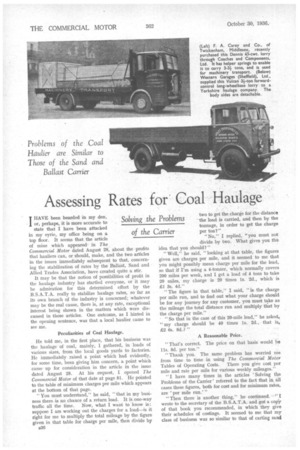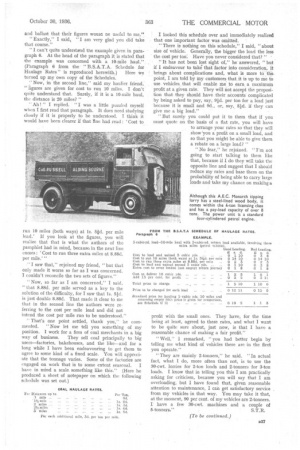Assessing Rates for Coal Haulage
Page 36

Page 37

If you've noticed an error in this article please click here to report it so we can fix it.
y HAVE been bearded in ray den, I or, perhaps, it is more accurate to state that I have been attacked in my eyrie, my office being on a top floor. It seems that the article of mine which appearedin The Commercial Motor dated August 28, about the profits that hauliers can, or should, make, and the two articles in the issues immediately subsequent to that, concerning the stabilization of rates by the Ballast, Sand and Allied Trades Association, have created quite a stir.
It may be that the notion of possibilities of profit in the haulage industry has startled everyone, or it may be admiration for this determined effort by the B.S.A.T.A. really to stabilize haulage rates, so far as its own branch of the industry is concerned; whatever may be the real cause, there is, at any rate, exceptional interest being shown in the matters which *ere discussed in those articles. One outcome, as I hinted in the opening sentence, was that a local haulier came to see me.
Peculiarities of Coal Haulage.
• He told me, in the first place, that his business was the haulage of coal, mainly, I gathered, in loads of various sizes, from the local goods yards to factories. He immediately raised a point which had evidently, for some time, been giving him concern, a point which came up for consideration in the article in the issue dated August 28. At his request, I opened The Commercial Motor of that date at page 81. He pointed to the table of minimum charges per mile which appears at the bottom of that page.
"You must understand," he said, " that in my business there is no chance of a return load. It is one-way traffic all the time. Now, what I want to know is: suppose I am working out the charges for a load—is it right for me to multiply the total mileage by the figure given in that table for charge per mile, then divide by B26 two to get the charge for the distance the load is carried, and then by the tonnage, in order to get the charge per ton?"
"No," I replied, "you must not divide by two. What gives you the idea that you should?"
"Well," he said, "looking at that table, the figures given are charges per mile, and it seemed to me that you might possibly mean charge per mile for the lead, so that if I'm using a 4-tonner, which normally covers 200 miles per week, and I get a load of 4 tons to take '20 miles, my charge is 20 times ls. 2d., which is E1 3s. 4d."
"The figure in that table," I said, "is the charge per mile ran, and to find out what your charge should be for any journey for any customer, you must take as the mileage the total distance run and multiply that by the charge per mile." ' "SO that in the case of this 20-mile lead," he asked, "my charge should be 40 times ls. 2d., that is, £2 6s. 8d.? "
A Reasonable Price.
"That's correct. The price on that basis would be lls. 8d. per ton."
"Thank you. The same problem has worried me from time to time in using The Commercial Motor Tables of Operating Costs. There you give cost per mile and rate per mile for various weekly mileages."
"I have many times in the articles 'Solving the Problems of the Carrier' referred to the fact that in all cases these figures, both for cost and for minimum rates, are per mile run.'"
"Then there is another thing," he continued. "I wrote to the secretary of the B.S.A.T.A. and got a coiy of that book you recommended, in which they give their schedules of castings. It seemed to me that my class of business was so similar to that of carting sand
and ballast that their figures wouict be useful to me." "Exactly," I said "I am very glad you did take that course."
" I can't quite understand the example given in paragraph 6. At the head of the paragraph it is stated_ that the example was concerned with a 10-mile haul." (Paragraph 6 from the " B.S.A.T.A. Schedule for Haulage Rates" is reproduced herewith.) Here we turned up my own copy of the Schedules.
" Now, in the second line," said my haulier friend, "figures are given for cost to run 10 miles. I don't quite understand that. Surely, if it is a 10-mile haul, the distance is 20 miles? "
" " I replied. "I was a little puzzled myself when I first read that paragraph. It does need studying closely if it is properly to be understood. I think it would have been clearer if that line had read : 'Cost to run 10 miles (both ways) at is. 51d. per mile lead.' If you look at the figures, you will realize that that is what the authors of the pamphlet had in mind, becauso in the next line comes: Cost to run three extra-miles at 8.88d. per mile.' " "I saw that," rejoined my friend, "but that only made it worse so far as I was concerned. I couldn't reconcile the two sets of figures."
"Now, so far as I am concerned," I said, " that 8.88d. per mile served as a key to the solution of the difficulty, for I saw that Is. ncl. is just double 8.88d. That made it clear to me that in the second line the authors were referring to the cost per mile lead and did not intend the cost per mile run to be understood."
"That's one point settled, thank you," he commented. "Now let me tell you something of my position. I work for a firm of coal merchants in a big way of business. They sell coal principally to big users—factories, bakehouses, and the like—and for a long while I have been endeavouring to get them to agree to some kind of a fixed scale. You will appreciate that the tonnage varies. Some of the factories are engaged on work that is to some extent seasonal. I have in mind a scale. something like this." (Here he produced a sheet of notepaper on which the following schedule was set out.) I looked this schedule over and immediately realized that one 'important factor was omitted. '
" There is nothing on this 'schedule," I said, "about size of vehicle. Generally, the bigger the load the less the cost per ton'. Have you never considered that?" ,
"It has not been lost sight of," he answered, "but if I endeavour to take that factor into consideration, it brings about complications and what is more to _the-. point, I am told by my customers, that, it is up to me to use vehicles., that will enable me to earn, a maximum profit at a given rate. They will not accept the proposition that they should have their accounts complicated by being asked to pay, say, 9id. per ton for a load just because it is small and 9d., or, say,. 81c1. if they can give me a big load."
"But surely you could put it to them that if you must quote on the basis of a flat rate, you will have to arrange your rates so that they will show you a profit on a small load, and so that you might be able to give them a rebate on a large load? "
"No fear," he rejoined. "I'm not going to start talking to them like that, because if I do they will take the opposite line and suggest that I should reduce my rates and base them on the probability of being able to carry large loads and take my chance on makihg a profit with the small ones. They have, for the time being at least, agreed to these rates, and what I want to be quite sure about, just now, is that I have a reasonable chance of making a fair profit."
"Well," I remarked, "you had better begin by telling me what kind of vehicles there are in the fleet you operate."
"They are mainly 2-tonners," he said. "In actual fact, what I do, more often than not, is to use the 30-cwt. lorries for 2-ton loads and 2-tanners for 3-ton loads. I know that in telling you this I am practically asking for criticism, because you will say that I am overloading, but I have found that, given reasonable attention to maintenance, I can get satisfactory service from my vehicles in that way. You may take it that, at the moment, 90 per cent. of my vehicles are 2-tonners. I have a few 30-cwt. machines and a couple of 5-tonners." S.T.R.




















































































